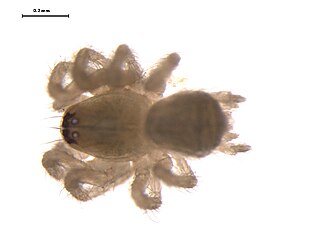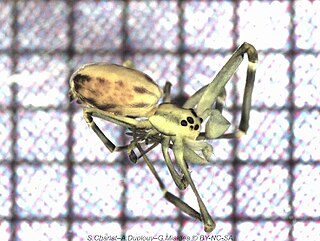
Uloboridae is a family of non-venomous spiders, known as cribellate orb weavers or hackled orb weavers. Their lack of venom glands is a secondarily evolved trait. Instead, they wrap their prey thoroughly in silk, cover it in regurgitated digestive enzymes, and then ingest the liquified body.
Mesozygiella is an extinct genus of orb-weaving spider, with one known species, Mesozygiella dunlopi, dating from the Early Cretaceous, making it the earliest orb-weaver yet discovered. Two male specimens of the species were found embedded in amber in Álava, northern Spain. The fossils provide direct evidence that the three major orb weaving families, namely Araneidae, Tetragnathidae and Uloboridae, had evolved by this time, about 140 million years ago. They probably originated during the Jurassic. All three families very likely have a common origin.

Philoponella is a genus of uloborid spiders. Like all Uloboridae, these species have no venom.

Cribellum literally means "little sieve", and in biology the term generally applies to anatomical structures in the form of tiny perforated plates.

Uloborus is a spider genus in the family Uloboridae with 80 described species. Most species occur in the tropics and subtropics, with only few species in northern America and Europe.
Sybota is a genus of uloborid spiders, found in Chile and Argentina.

The Euctenizidae are a family of mygalomorph spiders. They are now considered to be more closely related to Idiopidae.

Uloborus glomosus is a species of spider in the family Uloboridae. It is one of only a few Uloborus species found in North America and the only species found in Canada. Like all other species in the Uloboridae, Uloborus glomosus does not possess venom glands, relying instead on cribellate, a fuzzy non sticky silk that they use to trap and then wrap their prey. This species exhibits different disturbance behaviors depending on factors such as the time of day, and presence of eggsacs in the web. They may jump from the web, move to the edge, remain in the center, or jerk the web to shake it. If eggsacs are present, the female spider will jerk at the web and if not present, then the female spider will walk to the opposite side of the web.
Apomastus is a genus of North American mygalomorph spiders in the family Euctenizidae, and was first described by Jason Bond & B. D. Opell in 2002. As of May 2019 it contains only two species, both found in the Los Angeles Basin of southern California: A. kristenae and A. schlingeri.

Neoantistea is a genus of dwarf sheet spiders that was first described by Willis J. Gertsch in 1934.
Astavakra is a genus of spiders in the family Uloboridae. It was first described in 1967 by Lehtinen. As of 2017, it contains only one species, Astavakra sexmucronata, found in the Philippines.
Conifaber is a genus of spiders in the family Uloboridae. It was first described in 1982 by Opell. As of 2017, it contains 4 species, all from South America:
Daramulunia is a genus of spiders in the family Uloboridae. It was first described in 1967 by Lehtinen. As of 2017, it contains 2 species.
Lubinella is a genus of spiders in the family Uloboridae. It was first described in 1984 by Opell. This genus was named after arachnologist Yael D. Lubin. As of 2017, it contains only one species, Lubinella morobensis, from New Guinea.

Octonoba is a genus of Asian cribellate orb weavers first described in 1979 by Brent Opell. Members of this genus and those of Purumitra both have a large concave median apophysis and a conspicuous hematodocha. However, these spiders are generally much larger, with a carapace greater than 1.4 millimeters long, where those of Purumitra are usually less than 1 millimeter long.
Orinomana is a genus of spiders in the family Uloboridae. It was first described in 1934 by Strand. As of 2017, it contains 7 South American species.
Polenecia is a genus of spiders in the family Uloboridae. It was first described in 1967 by Lehtinen. As of 2017, it contains only one species, Polenecia producta, with a range of "Mediterranean to Azerbaijan".

Waitkera is a genus of spiders in the family Uloboridae. It was first described in 1979 by Opell. As of 2021, it contains only one species, Waitkera waitakerensis, found in New Zealand.

Lehtineniana is a genus of South Pacific cribellate orb-weavers first described by Danniella Sherwood in 2022.








